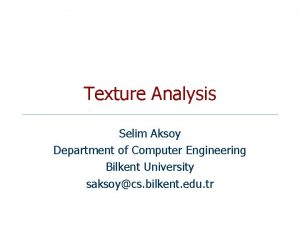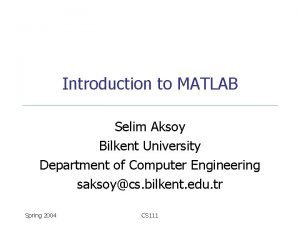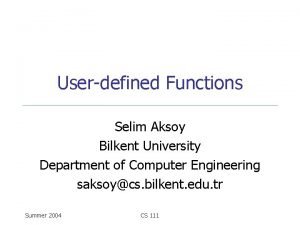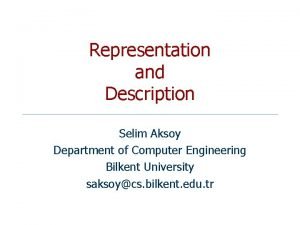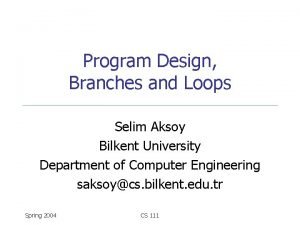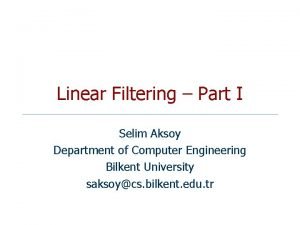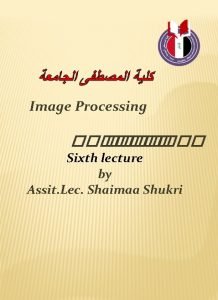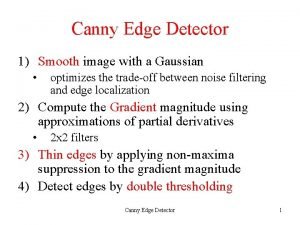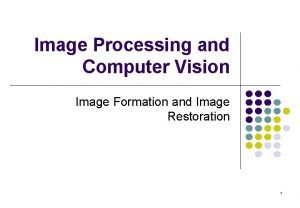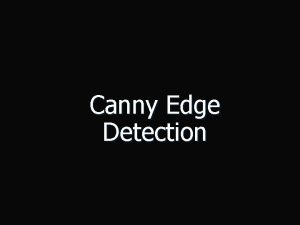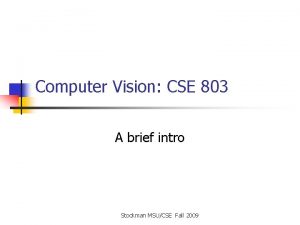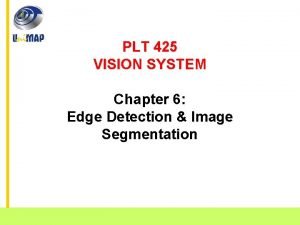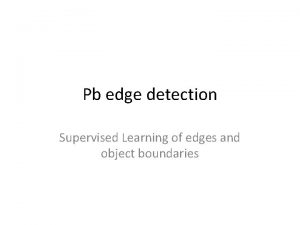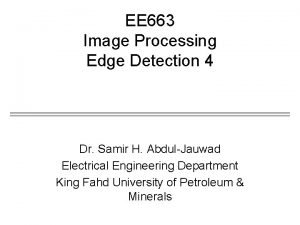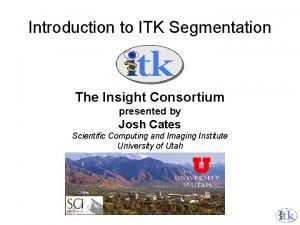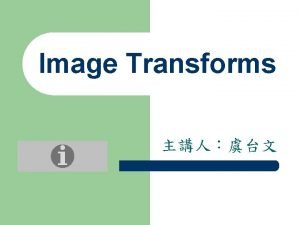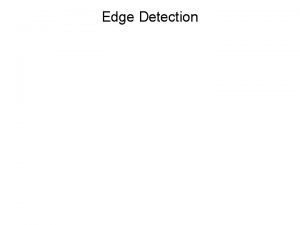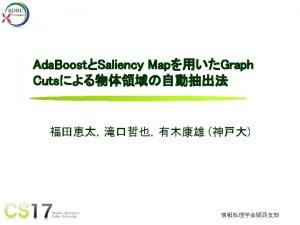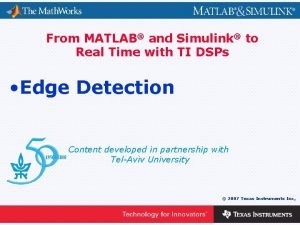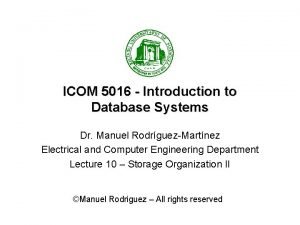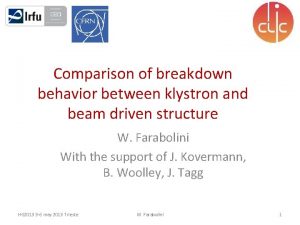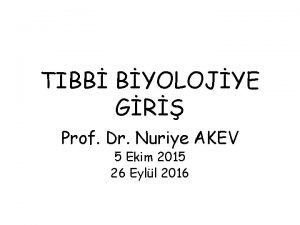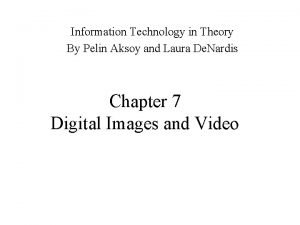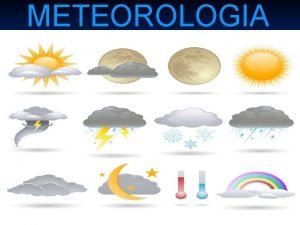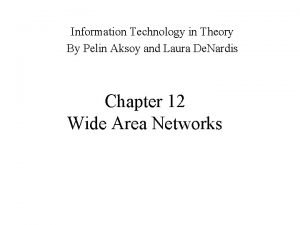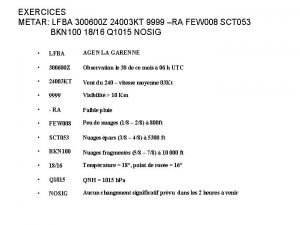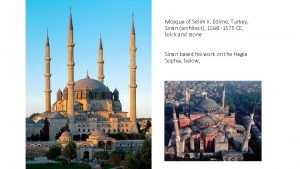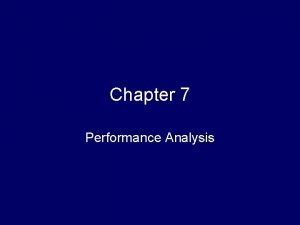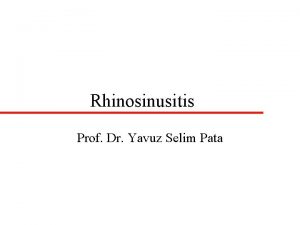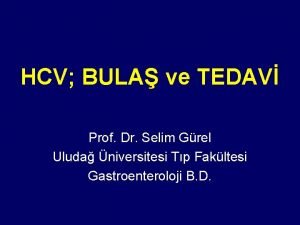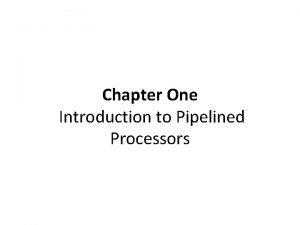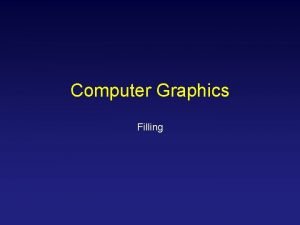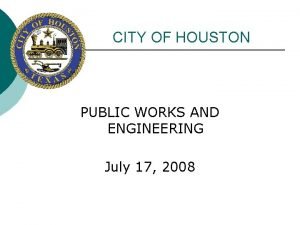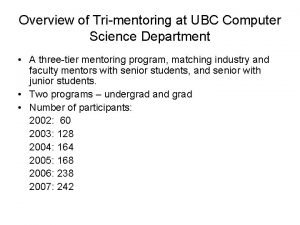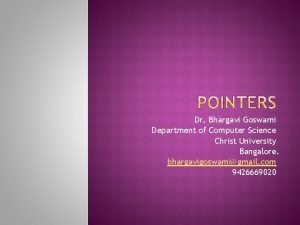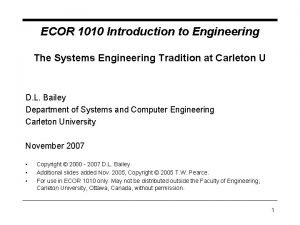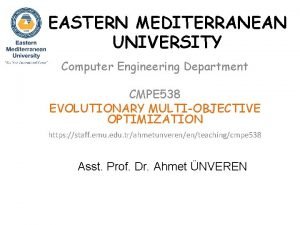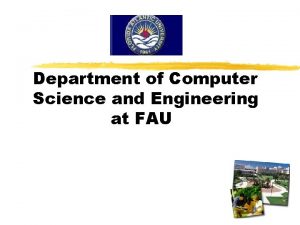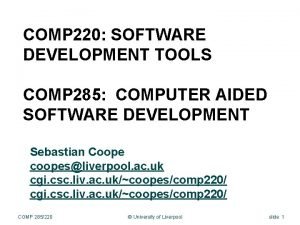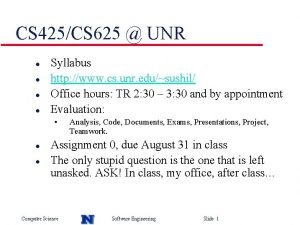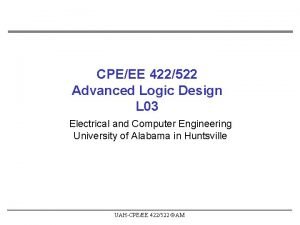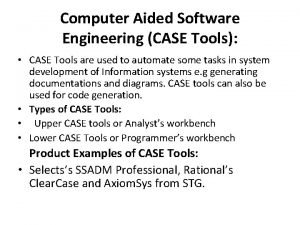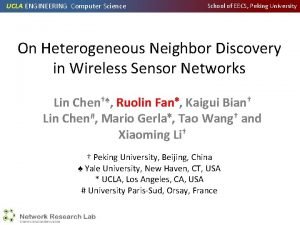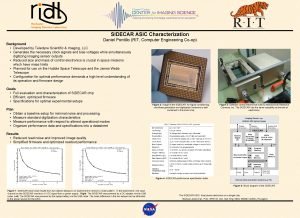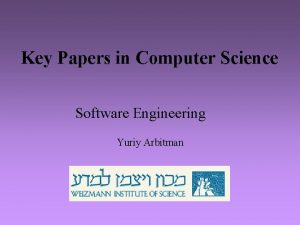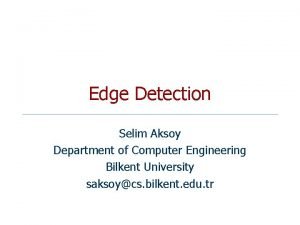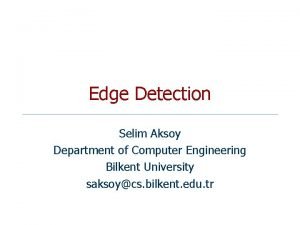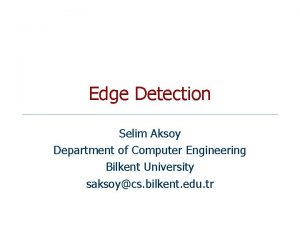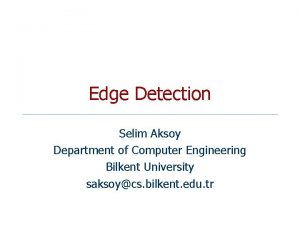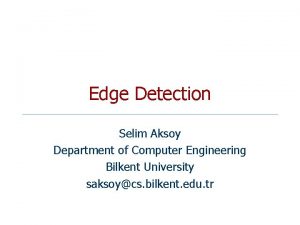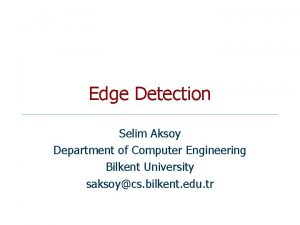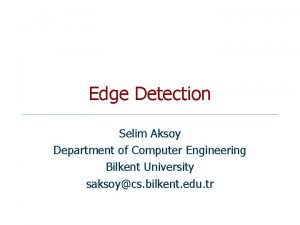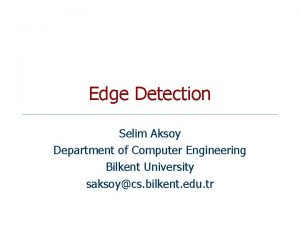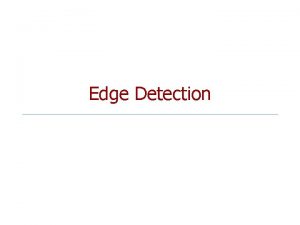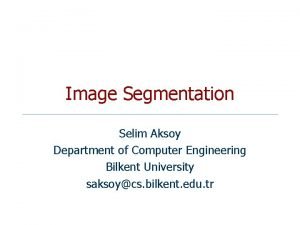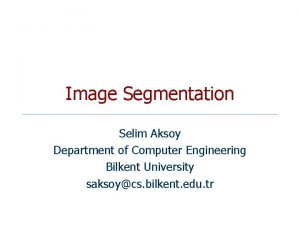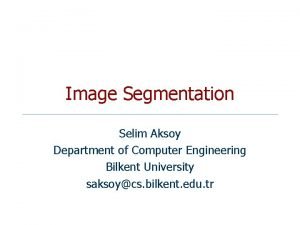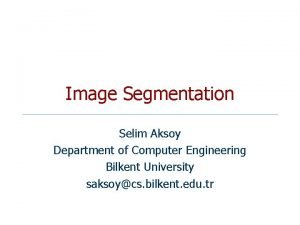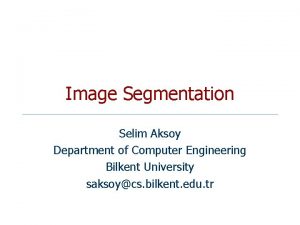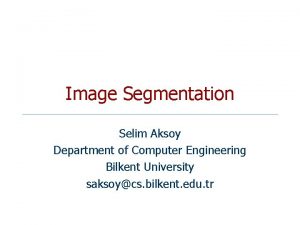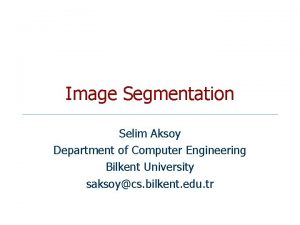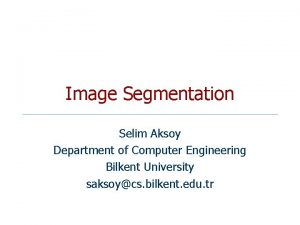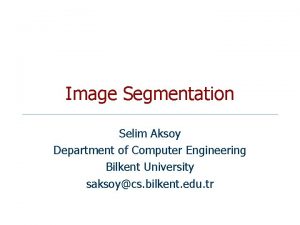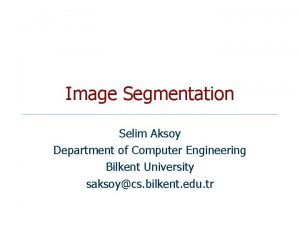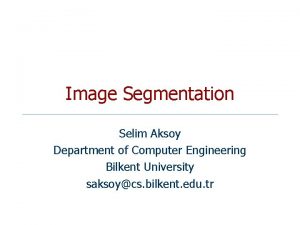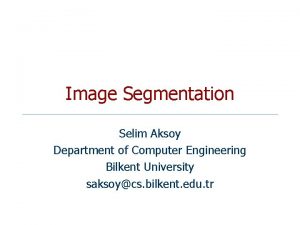Edge Detection Selim Aksoy Department of Computer Engineering



























































































- Slides: 91

Edge Detection Selim Aksoy Department of Computer Engineering Bilkent University saksoy@cs. bilkent. edu. tr

Edge detection n n Edge detection is the process of finding meaningful transitions in an image. The points where sharp changes in the brightness occur typically form the border between different objects or scene parts. These points can be detected by computing intensity differences in local image regions. Initial stages of mammalian vision systems also involve detection of edges and local features. CS 484, Spring 2010 © 2010, Selim Aksoy 2

Edge detection n Sharp changes in the image brightness occur at: n Object boundaries n n Reflectance changes n n A light object may lie on a dark background or a dark object may lie on a light background. May have quite different characteristics - zebras have stripes, and leopards have spots. Cast shadows Sharp changes in surface orientation Further processing of edges into lines, curves and circular arcs result in useful features for matching and recognition. CS 484, Spring 2010 © 2010, Selim Aksoy 3

Edge detection n n Basic idea: look for a neighborhood with strong signs of change. Problems: 81 82 26 24 n n n Neighborhood size How to detect change 82 33 25 25 81 82 26 24 Differential operators: n n Attempt to approximate the gradient at a pixel via masks. Threshold the gradient to select the edge pixels. CS 484, Spring 2010 © 2010, Selim Aksoy 4

Edge models CS 484, Spring 2010 © 2010, Selim Aksoy 5

Difference operators for 1 D Adapted from Gonzales and Woods CS 484, Spring 2010 © 2010, Selim Aksoy 6

Difference operators for 1 D CS 484, Spring 2010 © 2010, Selim Aksoy Adapted from Gonzales and Woods 7

Edge detection n Three fundamental steps in edge detection: 1. Image smoothing: to reduce the effects of noise. 2. Detection of edge points: to find all image points that are potential candidates to become edge points. 3. Edge localization: to select from the candidate edge points only the points that are true members of an edge. CS 484, Spring 2010 © 2010, Selim Aksoy 8

Difference operators for 1 D CS 484, Spring 2010 © 2010, Selim Aksoy Adapted from Shapiro and Stockman 9

Difference operators for 1 D CS 484, Spring 2010 © 2010, Selim Aksoy Adapted from Shapiro and Stockman 10

Observations n Properties of derivative masks: n n Coordinates of derivative masks have opposite signs in order to obtain a high response in signal regions of high contrast. The sum of coordinates of derivative masks is zero so that a zero response is obtained on constant regions. First derivative masks produce high absolute values at points of high contrast. Second derivative masks produce zero-crossings at points of high contrast. CS 484, Spring 2010 © 2010, Selim Aksoy 11

Smoothing operators for 1 D CS 484, Spring 2010 © 2010, Selim Aksoy 12

Observations n Properties of smoothing masks: n n n Coordinates of smoothing masks are positive and sum to one so that output on constant regions is the same as the input. The amount of smoothing and noise reduction is proportional to the mask size. Step edges are blurred in proportion to the mask size. CS 484, Spring 2010 © 2010, Selim Aksoy 13

Difference operators for 2 D CS 484, Spring 2010 © 2010, Selim Aksoy 14

Difference operators for 2 D CS 484, Spring 2010 © 2010, Selim Aksoy 15

Difference operators for 2 D Adapted from Gonzales and Woods CS 484, Spring 2010 © 2010, Selim Aksoy 16

Difference operators for 2 D original image CS 484, Spring 2010 gradient magnitude © 2010, Selim Aksoy thresholded gradient magnitude Adapted from Linda Shapiro, U of Washington 17

Difference operators for 2 D CS 484, Spring 2010 © 2010, Selim Aksoy 18

Difference operators for 2 D CS 484, Spring 2010 © 2010, Selim Aksoy 19

Difference operators for 2 D CS 484, Spring 2010 © 2010, Selim Aksoy 20

Gaussian smoothing and edge detection n n We can smooth the image using a Gaussian filter and then compute the derivative. Two convolutions: one to smooth, then another one to differentiate? Actually, no - we can use a derivative of Gaussian filter because differentiation is convolution and convolution is associative. CS 484, Spring 2010 © 2010, Selim Aksoy 21

Derivative of Gaussian CS 484, Spring 2010 © 2010, Selim Aksoy Adapted from Michael Black, Brown University 22

Derivative of Gaussian CS 484, Spring 2010 © 2010, Selim Aksoy Adapted from Michael Black, Brown University 23

Derivative of Gaussian CS 484, Spring 2010 © 2010, Selim Aksoy Adapted from Martial Hebert, CMU 24

Difference operators for 2 D CS 484, Spring 2010 © 2010, Selim Aksoy 25

Gaussian smoothing and edge detection CS 484, Spring 2010 © 2010, Selim Aksoy 26

Gaussian smoothing and edge detection CS 484, Spring 2010 © 2010, Selim Aksoy Adapted from Shapiro and Stockman 27

Gaussian smoothing and edge detection CS 484, Spring 2010 © 2010, Selim Aksoy Adapted from Steve Seitz, U of Washington 28

Laplacian of Gaussian Adapted from Gonzales and Woods CS 484, Spring 2010 © 2010, Selim Aksoy 29

Laplacian of Gaussian Adapted from Shapiro and Stockman CS 484, Spring 2010 © 2010, Selim Aksoy 30

Laplacian of Gaussian sigma=4 Lo. G zero crossings Gradient threshold=4 Gradient threshold=1 sigma=2 CS 484, Spring 2010 © 2010, Selim Aksoy Adapted from David Forsyth, UC Berkeley 31

Canny edge detector n Canny defined three objectives for edge detection: 1. Low error rate: All edges should be found and there should be no spurious responses. 2. Edge points should be well localized: The edges located must be as close as possible to the true edges. 3. Single edge point response: The detector should return only one point for each true edge point. That is, the number of local maxima around the true edge should be minimum. CS 484, Spring 2010 © 2010, Selim Aksoy 32

Canny edge detector 1. Smooth the image with a Gaussian filter with spread σ. 2. Compute gradient magnitude and direction at each pixel of the smoothed image. 3. Zero out any pixel response less than or equal to the two neighboring pixels on either side of it, along the direction of the gradient (non-maxima suppression). 4. Track high-magnitude contours using thresholding (hysteresis thresholding). 5. Keep only pixels along these contours, so weak little segments go away. CS 484, Spring 2010 © 2010, Selim Aksoy 33

Canny edge detector n Non-maxima suppression: n n Gradient direction is used to thin edges by suppressing any pixel response that is not higher than the two neighboring pixels on either side of it along the direction of the gradient. This operation can be used with any edge operator when thin boundaries are wanted. Note: Brighter squares illustrate stronger edge response. CS 484, Spring 2010 © 2010, Selim Aksoy Adapted from Martial Hebert, CMU 34

Canny edge detector n Hysteresis thresholding: n n Once the gradient magnitudes are thinned, high magnitude contours are tracked. In the final aggregation phase, continuous contour segments are sequentially followed. Contour following is initiated only on edge pixels where the gradient magnitude meets a high threshold. However, once started, a contour may be followed through pixels whose gradient magnitude meet a lower threshold (usually about half of the higher starting threshold). CS 484, Spring 2010 © 2010, Selim Aksoy 35

Canny edge detector CS 484, Spring 2010 © 2010, Selim Aksoy Adapted from Martial Hebert, CMU 36

Canny edge detector Adapted from Martial Hebert, CMU CS 484, Spring 2010 © 2010, Selim Aksoy 37

Canny edge detector CS 484, Spring 2010 © 2010, Selim Aksoy Adapted from Martial Hebert, CMU 38

Canny edge detector CS 484, Spring 2010 © 2010, Selim Aksoy Adapted from Martial Hebert, CMU 39

Canny edge detector CS 484, Spring 2010 © 2010, Selim Aksoy 40

Canny edge detector CS 484, Spring 2010 © 2010, Selim Aksoy 41

Canny edge detector n n n The Canny operator gives single-pixel-wide images with good continuation between adjacent pixels. It is the most widely used edge operator today; no one has done better since it came out in the late 80 s. Many implementations are available. It is very sensitive to its parameters, which need to be adjusted for different application domains. CS 484, Spring 2010 © 2010, Selim Aksoy 42

Edge linking n Hough transform n n n Model fitting n n n Finding line segments Finding circles Fitting line segments Fitting ellipses Edge tracking CS 484, Spring 2010 © 2010, Selim Aksoy 43

Hough transform n n The Hough transform is a method for detecting lines or curves specified by a parametric function. If the parameters are p 1, p 2, … pn, then the Hough procedure uses an n-dimensional accumulator array in which it accumulates votes for the correct parameters of the lines or curves found on the image. b image m accumulator y = mx + b CS 484, Spring 2010 © 2010, Selim Aksoy Adapted from Linda Shapiro, U of Washington 44

Hough transform: line segments CS 484, Spring 2010 © 2010, Selim Aksoy Adapted from Steve Seitz, U of Washington 45

Hough transform: line segments CS 484, Spring 2010 © 2010, Selim Aksoy Adapted from Steve Seitz, U of Washington 46

Hough transform: line segments Adapted from Gonzales and Woods CS 484, Spring 2010 © 2010, Selim Aksoy 47

Hough transform: line segments n n y = mx + b is not suitable (why? ) The equation generally used is: d = r sin(θ) + c cos(θ). c d r CS 484, Spring 2010 d is the distance from the line to origin. θ is the angle the perpendicular makes with the column axis. © 2010, Selim Aksoy Adapted from Linda Shapiro, U of Washington 48

Hough transform: line segments CS 484, Spring 2010 © 2010, Selim Aksoy Adapted from Shapiro and Stockman 49

Hough transform: line segments CS 484, Spring 2010 © 2010, Selim Aksoy 50

Hough transform: line segments CS 484, Spring 2010 © 2010, Selim Aksoy 51

Hough transform: line segments n 1. 2. Extracting the line segments from the accumulators: Pick the bin of A with highest value V While V > value_threshold { 1. 2. 3. 4. 5. order the corresponding pointlist from PTLIST merge in high gradient neighbors within 10 degrees create line segment from final point list zero out that bin of A pick the bin of A with highest value V } CS 484, Spring 2010 © 2010, Selim Aksoy Adapted from Linda Shapiro, U of Washington 52

Hough transform: line segments CS 484, Spring 2010 © 2010, Selim Aksoy 53

Hough transform: line segments CS 484, Spring 2010 © 2010, Selim Aksoy 54

Hough transform: circles n n Main idea: The gradient vector at an edge pixel points the center of the circle. Circle equations: n n r = r 0 + d sin(θ) c = c 0 + d cos(θ) r 0, c 0, d are parameters d CS 484, Spring 2010 *(r, c) © 2010, Selim Aksoy Adapted from Linda Shapiro, U of Washington 55

Hough transform: circles CS 484, Spring 2010 © 2010, Selim Aksoy Adapted from Shapiro and Stockman 56

Hough transform: circles CS 484, Spring 2010 © 2010, Selim Aksoy Adapted from Shapiro and Stockman 57

Hough transform: circles CS 484, Spring 2010 © 2010, Selim Aksoy Adapted from Shapiro and Stockman 58

Model fitting n n n Mathematical models that fit data not only reveal important structure in the data, but also can provide efficient representations for further analysis. Mathematical models exist for lines, circles, cylinders, and many other shapes. We can use the method of least squares for determining the parameters of the best mathematical model fitting the observed data. CS 484, Spring 2010 © 2010, Selim Aksoy 59

Model fitting: line segments CS 484, Spring 2010 © 2010, Selim Aksoy Adapted from Martial Hebert, CMU 60

Model fitting: line segments CS 484, Spring 2010 © 2010, Selim Aksoy 61

Model fitting: line segments CS 484, Spring 2010 © 2010, Selim Aksoy 62

Model fitting: line segments CS 484, Spring 2010 © 2010, Selim Aksoy 63

Model fitting: line segments n Problems in fitting: n n n Outliers Error definition (algebraic vs. geometric distance) Statistical interpretation of the error (hypothesis testing) Nonlinear optimization High dimensionality (of the data and/or the number of model parameters) Additional fit constraints CS 484, Spring 2010 © 2010, Selim Aksoy 64

Model fitting: ellipses CS 484, Spring 2010 © 2010, Selim Aksoy 65

Model fitting: ellipses CS 484, Spring 2010 © 2010, Selim Aksoy Adapted from Andrew Fitzgibbon, PAMI 1999 66

Model fitting: ellipses CS 484, Spring 2010 © 2010, Selim Aksoy Adapted from Andrew Fitzgibbon, PAMI 1999 67

Model fitting: incremental line fitting Adapted from David Forsyth, UC Berkeley CS 484, Spring 2010 © 2010, Selim Aksoy 68

Model fitting: incremental line fitting CS 484, Spring 2010 © 2010, Selim Aksoy Adapted from Trevor Darrell, MIT 69

Model fitting: incremental line fitting CS 484, Spring 2010 © 2010, Selim Aksoy Adapted from Trevor Darrell, MIT 70

Model fitting: incremental line fitting CS 484, Spring 2010 © 2010, Selim Aksoy Adapted from Trevor Darrell, MIT 71

Model fitting: incremental line fitting CS 484, Spring 2010 © 2010, Selim Aksoy Adapted from Trevor Darrell, MIT 72

Model fitting: incremental line fitting CS 484, Spring 2010 © 2010, Selim Aksoy Adapted from Trevor Darrell, MIT 73

Edge tracking n Mask-based approach uses masks to identify the following events: n n n start of a new segment, interior point continuing a segment, end of a segment, junction between multiple segments, corner that breaks a segment into two. junction corner CS 484, Spring 2010 © 2010, Selim Aksoy Adapted from Linda Shapiro, U of Washington 74

Edge tracking: ORT Toolkit n n n Designed by Ata Etemadi. The algorithm is called Strider and is like a spider moving along pixel chains of an image, looking for junctions and corners. It identifies them by a measure of local asymmetry. n n n When it is moving along a straight or curved segment with no interruptions, its legs are symmetric about its body. When it encounters an obstacle (i. e. , a corner or junction) its legs are no longer symmetric. If the obstacle is small (compared to the spider), it soon becomes symmetrical. If the obstacle is large, it will take longer. The accuracy depends on the length of the spider and the size of its stride. n The larger they are, the less sensitive it becomes. CS 484, Spring 2010 © 2010, Selim Aksoy 75

Edge tracking: ORT Toolkit The measure of asymmetry is the angle between two line segments. angle 0 here L 1: the line segment from pixel 1 of the spider to pixel N-2 of the spider L 2: the line segment from pixel 1 of the spider to pixel N of the spider The angle must be <= arctan(2/length(L 2)) Longer spiders allow less of an angle. CS 484, Spring 2010 © 2010, Selim Aksoy Adapted from Linda Shapiro, U of Washington 76

Edge tracking: ORT Toolkit n n The parameters are the length of the spider and the number of pixels per step. These parameters can be changed to allow for less sensitivity, so that we get longer line segments. The algorithm has a final phase in which adjacent segments whose angle differs by less than a given threshold are joined. Advantages: n n n Works on pixel chains of arbitrary complexity. Can be implemented in parallel. No assumptions and parameters are well understood. CS 484, Spring 2010 © 2010, Selim Aksoy 77

Example: building detection by Yi Li @ University of Washington CS 484, Spring 2010 © 2010, Selim Aksoy 78

Example: building detection CS 484, Spring 2010 © 2010, Selim Aksoy 79

Example: object extraction by Serkan Kiranyaz Tampere University of Technology CS 484, Spring 2010 © 2010, Selim Aksoy 80

Example: object extraction CS 484, Spring 2010 © 2010, Selim Aksoy 81

Example: object extraction CS 484, Spring 2010 © 2010, Selim Aksoy 82

Example: object extraction CS 484, Spring 2010 © 2010, Selim Aksoy 83

Example: object recognition n Mauro Costa’s dissertation at the University of Washington for recognizing 3 D objects having planar, cylindrical, and threaded surfaces: n n n Detects edges from two intensity images. From the edge image, finds a set of high-level features and their relationships. Hypothesizes a 3 D model using relational indexing. Estimates the pose of the object using point pairs, line segment pairs, and ellipse/circle pairs. Verifies the model after projecting to 2 D. CS 484, Spring 2010 © 2010, Selim Aksoy 84

Example: object recognition Example scenes used. The labels “left” and “right” indicate the direction of the light source. CS 484, Spring 2010 © 2010, Selim Aksoy 85

CS 484, Spring 2010 © 2010, Selim Aksoy 86

Example: object recognition CS 484, Spring 2010 © 2010, Selim Aksoy 87

Example: object recognition CS 484, Spring 2010 © 2010, Selim Aksoy 88

Example: object recognition 1 coaxialsmulti encloses 1 CS 484, Spring 2010 2 3 2 ellipse e encloses 3 parallel lines 1 2 coaxial e 3 c 2 Relationship graph and the corresponding 2 -graphs. © 2010, Selim Aksoy 89

Example: object recognition n n Learning phase: relational indexing by encoding each 2 -graph and storing in a hash table. Matching phase: voting by each 2 -graph observed in the image. CS 484, Spring 2010 © 2010, Selim Aksoy 90

Example: object recognition Incorrect hypothesis 1. 2. 3. CS 484, Spring 2010 © 2010, Selim Aksoy The matched features of the hypothesized object are used to determine its pose. The 3 D mesh of the object is used to project all its features onto the image. A verification procedure checks how well the object features line up with edges on the image. 91
 Selim aksoy bilkent
Selim aksoy bilkent Matlab bilkent
Matlab bilkent Selim aksoy bilkent
Selim aksoy bilkent Selim aksoy bilkent
Selim aksoy bilkent Selim aksoy
Selim aksoy Selim aksoy bilkent
Selim aksoy bilkent Selim aksoy
Selim aksoy Linear filtering
Linear filtering Edge detection sobel
Edge detection sobel Edge detection
Edge detection What is canny edge detection in image processing
What is canny edge detection in image processing Ocr thai
Ocr thai Leading edge detection
Leading edge detection Edge detection
Edge detection Edge detection
Edge detection Edge detection
Edge detection Convolution edge detection
Convolution edge detection Edge detection
Edge detection Edge detection
Edge detection Edge detection
Edge detection Edge detection
Edge detection Segmentation
Segmentation Simulink edge detection
Simulink edge detection Tum department of electrical and computer engineering
Tum department of electrical and computer engineering Computer engineering department
Computer engineering department Rising edge and falling edge
Rising edge and falling edge Hayvan hücresi ve bitki hücresi
Hayvan hücresi ve bitki hücresi Metar aksoy
Metar aksoy Shihomi ara aksoy
Shihomi ara aksoy Remzi can aksoy
Remzi can aksoy Pelin aksoy
Pelin aksoy Metar mps
Metar mps Yunus aksoy
Yunus aksoy Few sct brk ovc
Few sct brk ovc What is system in software engineering
What is system in software engineering Mosque of selim ii floor plan
Mosque of selim ii floor plan Selim akl
Selim akl Yavuz selim pata
Yavuz selim pata Sipahíjové
Sipahíjové Yavuz sultan selim mosque
Yavuz sultan selim mosque Prof dr selim gürel
Prof dr selim gürel Magdy selim
Magdy selim Error detection in computer networks
Error detection in computer networks Data hazard forwarding
Data hazard forwarding Hazard detection and resolution
Hazard detection and resolution Transmission error in computer networks
Transmission error in computer networks Error correction in computer networks
Error correction in computer networks Outcode in computer graphics
Outcode in computer graphics Scan line fill algorithm in computer graphics
Scan line fill algorithm in computer graphics Electrical engineering department
Electrical engineering department Engineering department in hotel
Engineering department in hotel City of houston idm
City of houston idm Engineering key performance indicators
Engineering key performance indicators Department of information engineering university of padova
Department of information engineering university of padova Department of information engineering university of padova
Department of information engineering university of padova Eacademics iitd ac in sportal login
Eacademics iitd ac in sportal login University of bridgeport engineering
University of bridgeport engineering University of bridgeport engineering
University of bridgeport engineering Ucla systems engineering
Ucla systems engineering University of sargodha engineering department
University of sargodha engineering department Ucl computer science bsc
Ucl computer science bsc Northwestern computer science department
Northwestern computer science department Computer science department rutgers
Computer science department rutgers Stanford computer science department
Stanford computer science department Computer science fsu
Computer science fsu Trimentoring
Trimentoring Bhargavi goswami
Bhargavi goswami Webnis
Webnis Forward engineering and reverse engineering
Forward engineering and reverse engineering Principles of complex systems for systems engineering
Principles of complex systems for systems engineering Elegant systems
Elegant systems Forward and reverse engineering
Forward and reverse engineering Klipsch school of electrical and computer engineering
Klipsch school of electrical and computer engineering Computer engineering companies
Computer engineering companies Software engineering vs computer science
Software engineering vs computer science Ecor 1010
Ecor 1010 Computer engineering
Computer engineering Citrix fau
Citrix fau Toolscomp
Toolscomp Ucf software engineering
Ucf software engineering An engineering approach to computer networking
An engineering approach to computer networking Erik jonsson school of engineering and computer science
Erik jonsson school of engineering and computer science Computer science and engineering unr
Computer science and engineering unr Uah computer engineering flowchart
Uah computer engineering flowchart Advantages of case tools in software engineering
Advantages of case tools in software engineering Ucla eecs
Ucla eecs Daniel pontillo
Daniel pontillo Computer-aided software engineering
Computer-aided software engineering Computer science software engineering
Computer science software engineering Hacettepe university computer engineering
Hacettepe university computer engineering Gadgets
Gadgets Erik jonsson school of engineering and computer science
Erik jonsson school of engineering and computer science
